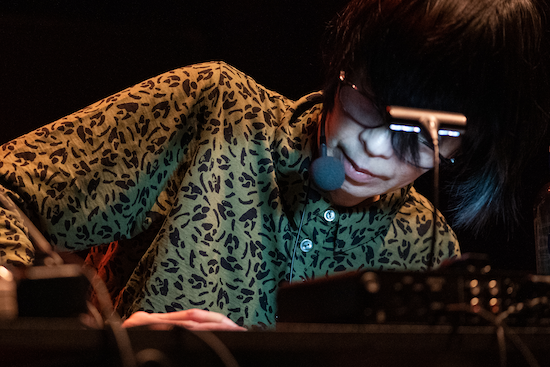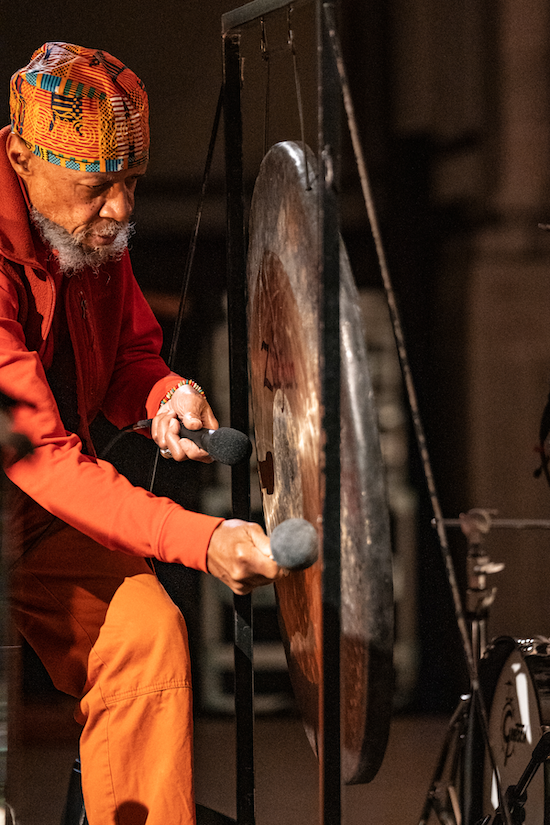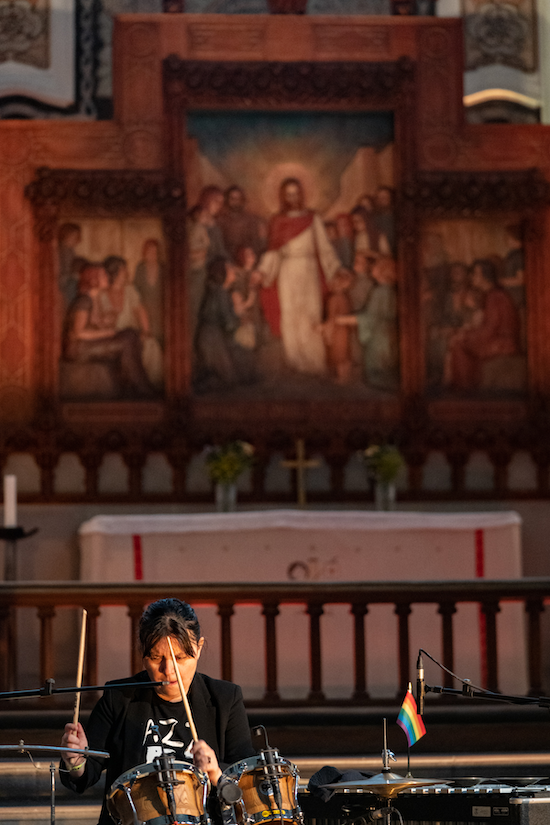Valentina Magaletti, photo by Camilla Rehnstrand
Standing in line to enter the Lutheran church of St. Johannes in Malmö, every time the door opens a hint of the sensory overwhelm to be found therein burst outwards into the early evening. A waft of incense, a glimpse of the ornate arch-shaped fresco that towers over the altar or the eye of providence that tops a massive stained-glass window, or the sound of Valentina Magaletti’s extraordinary drumming.
Once through the door she’s hard to see once I take a pew, visible only via the occasional arm flailing in the air or the shadow she casts against multi-coloured lights. Moving to a better vantage point, she’s still dwarfed by the space’s sublime art deco architecture, by the enormous pulpit to her left, the opulent organ up on a balcony to her right, the second, even larger organ on the other side of the hall. Dwarfed, that is, only physically. Sonically, with only her kit, a glockenspiel and a modest electronics setup she manages to match her surroundings’ sense of awe. She lays down strange, psychedelic loops which serve as beds, freeing her up to explore every percussive possibility. There are delicate flourishes, sections of thunderous free-form noise and everything in-between, augmented further by the occasional contrast of glockenspiel.
If Magaletti’s set matches these surroundings, utilised only for the Thursday evening as this year’s Intonal festival glides leisurely into gear, Laraaji then manages to somehow dwarf them in turn. He arrives onstage unnoticed by a fashionable young crowd who mill around chatting, until he chimes the Tibetan tingsha cymbals he wears around his neck. Behind him is an enormous gong and a grand piano, but he starts slowly and subtly with ambient clicks and whirrs. He is a master of pace, capable of emitting overwhelming volume that swamps every corner as it echoes through the church, but uses it sparingly. He half-sings, half-chants, and half-vocalises – and sometimes bursts into spontaneous laughter – along with his music’s immersive, melting ambient haze for 20 transporting minutes until he eventually sits at the piano. Here, his playing is suddenly hard and deliberate, his singing a smooth Rat Pack croon but augmented by the electronics he’s left running in the background. Later his voice takes on an edge of the blues, and later still he filters it through an eerie chipmunk effect. When he uses the gong it’s with grace and subtlety, and when he lets loose on the hammered dulcimer it’s genuinely euphoric.
Intonal is a festival that celebrates music of this kind, music that demands deep listening and rewards with moments of real transcendence. The next day, for instance, :zoviet*france: perform in the Big Room at Inkonst, the festival’s central venue and chief organising force. The screen behind Ben Ponton and Mark Warren depicts a forest which it takes a few moments to realise is in fact a video, rather than a still image – the leaves gently waving in the wind. They, too, take time to build momentum, deploying organ-rattling bass sparingly at first, but crescendoing glacially until it’s coming in great waves, as if the universe itself is taking great, heaving breaths. Ater half-an-hour they incorporate birdsong, and eventually a dynamic, rolling beat. Downstairs in the Black Box, Maya Shenfield unspools grandiose soundscapes of her own, capable of both intense prettiness and overwhelming power, while Pedro Maia’s visuals behind her – projected to stunning effect on a screen that spans the entire wall – subtly manipulate analogue film footage so that it takes on a strange and uncanny effect.
The festival’s opening salvos are enticing, but also temperate, although the rest of Intonal is to prove anything but sedate. Before he’s uttered a sound, the vocalist of Vanligt Folk exudes deranged intensity as he swaggers onstage like a cagefighter, for instance. He’s wearing nothing save for trainers and sports socks, a gaffer-tape jockstrap applied directly onto his crotch and smudged red lipstick. Visuals behind him, provided by the artist Tobias Toyberg (their collaboration, premiering for the first time tonight, is called ‘Dischorealism’) are a ludicrous non-stop cabaret of bloody faces, fetishistic films centred on cows udders, and loops of Katy Perry’s ‘California Girls’ video. The music is a thumping and relentless blend of gabba, industrial, EBM, hardcore punk, techno and harsh noise, the vocalist prowling and leaping like a demon, in and out of the crowd as he howls into two microphones at a time, flinging cups of water over his head, and then into the audience’s faces.
In the same room, at midnight, Coby Sey presents a set that’s similarly gripping, albeit in a totally different fashion. He and his band are barely visible on the dimly lit stage, their constantly shapeshifting music emerging like smoke amid the gloom. The music’s longform and ambitious – a simple line on glockenspiel will crescendo gradually over the course of ten minutes, from delicate minimalism into an all-out cataclysm of distorted noise – but always urgent and focussed. Sey has no qualms about letting a soundscape build and build before puncturing it with a killer, dubbed-out bassline and settling swiftly into a muscle-clenching groove. He might be barely visible, but he exudes spellbinding charisma. Across the weekend, there are many extraordinary sets, but none quite so complete as this one.

Phew, photo by Camilla Rehnstrand
When it comes to pure intensity, however, Rian Treanor’s collaboration with Mookie from the Jokkoo collective, finds a way to up the stakes even higher the following evening. In the Black Box, the crowd sit and stand in a semi-circle around a figure, slumped on the floor in a black sack under a spotlight. Until now, Saturday night has been relatively serene. Mihailis Shammas’ pin-drop minimalism in the Black Box consists of long, sustained notes slowly growing and shrinking, while a set of rich and moody ambient dubstep from Jay Glass Dubs accompanies his gloomily enticing short film #1 In England.
Treanor’s set, however, is at times so manic that it could incite a panic attack. He begins with thick, alien whirrs of noise as the figure in the sack starts writhing. Over time, the rhythm gets faster, faster and faster, glitchier and glitchier, and the figure struggles like a newborn fawn to its feet, then stumbles, then jumps, then – the music now at hyperspeed – starts whirling around like a banshee, spinning into the faces of the crowd. Even by Inkonst’s standards – a venue constantly bathed in copious amounts of dry ice – visibility is heavily clouded, but one-by-one, red lights appear under the sack, slowly adding a skeleton to this formerly shapeless sprite and cutting through the smog. At one point, the music slows to a near halt and the ghost collapses. In the darkness, the sack is removed to reveal the person inside. Stumbling to its feet once again, the process repeats, but this time the figure dons a strange mask of transparent tubing, affixed to his face like a baby Xenomorph. If the sprite it evolved from felt ambiguous in its intentions, now the creature is all-out terrifying. As Treanor plunges into total noise and ups the bass to a volume that should probably be illegal, strobe lights pound and pound as the figure howls – half-demon, half-grindcore vocalist – and lurches monstrously around the floor. Gradually, though, the person underneath starts to fight back. A few of the lights turn symbolically from red to white as it wrestles with the mask, trying with all its might to pull it off then pushing it back again and again. By the end, however he collapses once more, the performance ending in intriguing ambiguity.
Then, there is a palette-cleansing set from Phew. Playing in Inkonst’s Small Room, it’s a shame that at times it’s hard to hear her over the hubbub of a crowd getting drinks and catching up at the nearby bar, or getting in line for the next set in the Big Room. Luckily, Phew herself appears unphased by the unfortunate soundclash, entering into a kind of trance over her minimalist setup as she moves from playful experimental jazz to eerie abstraction to earnest piano balladeering. From thereon, the night then becomes a dizzying cornucopia. There’s reggae, techno, samba, pop and noise – and that’s just within Gavsborg’s blast of a two-hour DJ set. At the same tame in the Small Room, noise rock trio Statoil cast forth some enjoyably crushing instrumental psych metal – a genre they call ‘static-oil-core’, while downstairs the Black Box is transformed into the Black Box Disco Club once the clock turns midnight. There, Berghain resident DJ Fiedel holds sway until daybreak. For the first two hours, however, it’s the hypnotic flowing march of dancer Frédéric Gies – lean, hirsute and clothed in little but thin ropes – that provides the real centrepiece.

Laraaji, photo by Camilla Rehnstrand
After the intensity of Saturday night, Sunday’s programming seems deliberately curated to provide a balm. After a talk and brief performance from the Iranian artist Farzané, programmed by the organisation Konstmusiksystrar (Sisters In Contemporary Music), only the Black Box, now with rows of chairs and cushions to allow respite for shattered feet, is used for the live music programming. Perhaps the most anticipated is a collaboration between Julia Holter and Tashi Wada, for whom the room drops into total silence. All weekend, the quality of Inkonst’s 360-degree sound system has been remarkable, but it’s Holter and Wada who make the most use of its capabilities. While Holter constructs delicate lattices of keyboards and provides occasional vocals, Wada threads in a dizzying variety of sonics that often draw deep from centuries past. Early on he wields smallpipes, marching in a slow loop around the stage in a ceremonial fashion, while his keys are often manipulated to resemble harpsichords or church organs as they spiral around repeating leitmotifs throughout the duration of the set. It is at times sparse and fragmented. Between songs there are long stretches of silence as the two musicians reposition their sheet music, and within them they sometimes move in bursts of loud and quiet. Holter sometimes provides little more than a barely audible whisper when it comes to vocals. Such is the intimacy of the atmosphere – provided half by the musicians and half by the space itself – that the sparseness works in the set’s favour, providing a strange, though tantalising momentum.
The final live act of the weekend follows in the form of Alexis Langevin-Tétrault and Guillaume Côté. Like Maya Shenfield and Pedro Maia two nights prior, their set makes use of beautiful abstract visuals cast behind them onto Black Box’s enormous screen, though where Maia’s moved with slowness and heft like lava down a mountainside, the Canadian duo’s flicker manically like wide-open flames. Standing across from each other over a modular synth rig as they unspool great and enveloping sheets of sound the visuals take on a hallucinatory effect. Though composed of little but colours and abstract shapes, defined figures seem to emerge from the fray – the outlines of undiscovered continents, looming faces, and faded scenery. Even the shadows the musicians cast against the screen seem to morph, growing and shrinking, and moving curiously across the room.
Langevin-Tétrault and Côté’s set is short and sweet – barely half-an-hour in length – but Intonal isn’t quite done yet. The festival’s final night coincides with Walpurgis, public celebrations in honour of eighth century missionary Saint Walburga that are co-opted by many young Swedes as an excuse for heavy drinking and partying. Ever the shapeshifting space, Inkonst morphs one more time into ‘Walpurgis Club’ where a succession of house and techno DJs provide partying all the way through into Mayday morning. This, however, feels like a coda. Intonal’s mission – to provide a platform in which challenging, boundary-pushing, concentration-demanding art can be celebrated to the fullest – has long since been completed.


